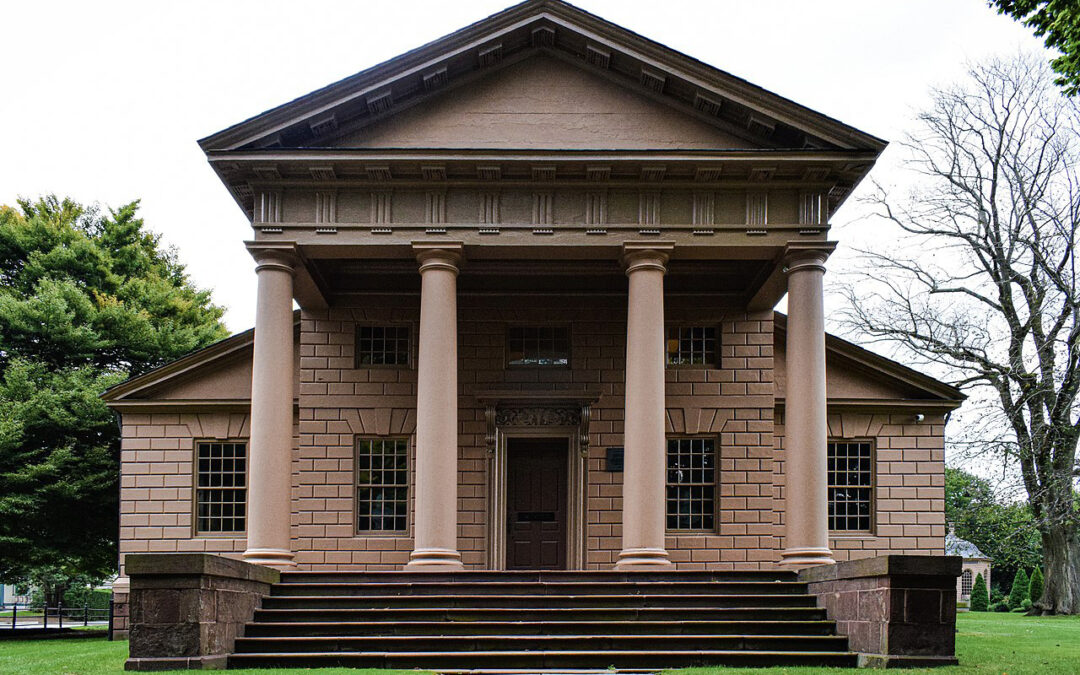The Redwood Library in Newport, Rhode Island, is one of the city’s most venerable buildings. This structure is home to the nation’s oldest circulating library still in its original building. Its creation was a product of the Philosophical Club, a group of leading local businessmen in the early part of the eighteenth century who gathered around the famous Bishop Berkeley, a colonial-era religious leader, and thinker. The group wished to establish a circulating library for use by its members and a place where they could meet and discuss issues of the day. The Library was founded in 1747 by 46 local businessmen. The two primary donors to the effort were Henry Collins, who provided the land at what was then the edge of the town settlement, and Abraham Redwood, who provided a generous sum to help acquire books for the new institution.
The man who was engaged to design the structure was Peter Harrison, a sea captain turned architect. Harrison was also the designer of other important colonial structures including the Brick Market (1761-72) and the Touro Synagogue (1759-63). It is believed that he emigrated from England to Newport around 1740 at age 24 but returned to England for a period to be trained in one of the studios maintained by the English gentry to teach architecture. At that time in England, the “Neo-Palladian” style was sweeping away Medieval styles, which had long predominated. This “new” style was based on the designs done nearly two hundred years earlier by Venetian Architect Andrea Palladio, who was emulating the classical architectural forms of Rome and Greece nearly two thousand years earlier! Peter Harrison is often credited as being the first American “architect” because he was perhaps the first to be taught architecture and to have his designs built by others. This was a large change from the Design-Builders, like Richard Munday and Asher Benjamin, who dominated construction during the earlier part of the 17th century.
There is little doubt that Peter Harrison drew his design for the Redwood directly from Palladio’s sketches that had been published in books. Harrison’s genius was less in raw invention than in a skillful translation of two-dimensional images into workable three-dimensional buildings of quality and rich character. The Redwood Library is often credited with being the first classically-inspired public building in North America and had a major influence on Thomas Jefferson, who studied the building closely during a visit he made to Newport in 1784. The connotation of the Greek democratic tradition that is implied by the pedimented façade was a natural fit for a nation seeking to revive a political tradition absent for fifteen centuries. The tradition of American Classical architecture begun at the Redwood was emulated in Jefferson’s design for the University of Virginia and continues to be a major theme in courthouses, high schools, and other public buildings built to this day.
Over the years many architects have had an important hand in extending and renovating the structure including George Champlin Mason (1912-13), John Russell Pope (1978-79), and Shepley Bulfinch (1997-2006). Often it is not just the architects, but those people who raise the attention and money required, who deserve the most credit. Ralph Carpenter is a Newporter revered for his efforts to restore Trinity Church, the Brick Market, and (most recently) the Redwood Library. This gentleman of 97 years is as active and sharp as ever and has just seen the completion of an important project he conceived and helped promote — the publication of Newport: A Lively Experiment (1639-1969), authored by Rockwell Stensrud and financially underwritten by Gilbert Kahn and John Noffo Kahn. This beautifully produced and well-written volume is an in-depth examination of the people who founded and lived in Newport, their works, and (of course) their buildings. Although architecture is not the central theme of this publication, it is a continual thread that resonates throughout the volume, like the violin melody in symphonic composition. This book is the first work of the Redwood Library Press and is available for purchase at that magnificent Peter Harrison-designed building, which every admirer of architecture should take the time to see firsthand.
Looking to remodel your home? Let’s connect.
Join the Architectural Forum to stay up-to-date with architectural news from Rhode Island and abroad.
Ross Sinclair Cann, AIA, LEED AP, is a historian, educator, and practicing architect living and working in Newport. This article was initially published in ARCHI-TEXT, in Newport This Week, May 12, 2007.
